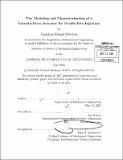| dc.contributor.advisor | Ian Hunter. | en_US |
| dc.contributor.author | Mendoza, Jonathan Michael | en_US |
| dc.contributor.other | Massachusetts Institute of Technology. Dept. of Mechanical Engineering. | en_US |
| dc.date.accessioned | 2012-04-26T18:52:47Z | |
| dc.date.available | 2012-04-26T18:52:47Z | |
| dc.date.copyright | 2011 | en_US |
| dc.date.issued | 2011 | en_US |
| dc.identifier.uri | http://hdl.handle.net/1721.1/70431 | |
| dc.description | Thesis (S.B.)--Massachusetts Institute of Technology, Dept. of Mechanical Engineering, 2011. | en_US |
| dc.description | Cataloged from PDF version of thesis. | en_US |
| dc.description | Includes bibliographical references (p. 67-68). | en_US |
| dc.description.abstract | The BioInstrumentation Laboratory at MIT developed a needle-free injector that is driven by a Lorentz-force actuator. The current model was able to generate pressures of up to 20 MPa in order to drive a jet of water based solution. In order to improve the needle-free injector, a new Lorentz-force actuator was designed and modeled using finite element analysis software. The new magnetic configuration included a radially-magnetized ring that generated a larger magnetic field across the airgap of the Lorentz-force actuator. Calculated peak forces were between 400 N and 600 N depending upon the position of the stroke length and the current density through the coil. Saturation in the steel core and casing, onsetting at a current density of about 108 A/m 2 , resulted in diminishing returns in force from an increasing current density. The rheological properties of poly(ortho) ester were measured for determining the feasibility of injecting viscous drug mediums. Of the two samples provided, the less viscous batch had a measured viscosity of 2.5 Pa-s and exhibited shear thinning at a shear rate of about 1000 s-1. Shear thinning has a large effect on the required pressure for injecting poly(ortho) ester at sufficient velocities. Finally, a benchtop experiment was designed and built to measure the force output of a BEI Kimco Lorentz-force linear actuator. A circuit was built to charge and discharge a capacitor that drives the output of the coil. Forces of up to 1000 N were measured at a stored capacitor voltage of 200 V. The time to peak force output was measured between 4 and 5 ms for high and low voltages respectively. Inefficient switching resulted in lower than expected forces below 40 V while increased resistance increased the damping of the overall system. Saturation was observed in the coil at voltages of 70 V and higher. The current capacity of the coil will continue to be pushed to the maximum stored value of 500 V. | en_US |
| dc.description.statementofresponsibility | by Jonathan Michael Mendoza. | en_US |
| dc.format.extent | 68 p. | en_US |
| dc.language.iso | eng | en_US |
| dc.publisher | Massachusetts Institute of Technology | en_US |
| dc.rights | M.I.T. theses are protected by
copyright. They may be viewed from this source for any purpose, but
reproduction or distribution in any format is prohibited without written
permission. See provided URL for inquiries about permission. | en_US |
| dc.rights.uri | http://dspace.mit.edu/handle/1721.1/7582 | en_US |
| dc.subject | Mechanical Engineering. | en_US |
| dc.title | The modeling and characterization of a Lorentz-force actuator for needle-free injection | en_US |
| dc.title.alternative | Lorentz-force actuator for needle-free injection | en_US |
| dc.type | Thesis | en_US |
| dc.description.degree | S.B. | en_US |
| dc.contributor.department | Massachusetts Institute of Technology. Department of Mechanical Engineering | |
| dc.identifier.oclc | 785217363 | en_US |
